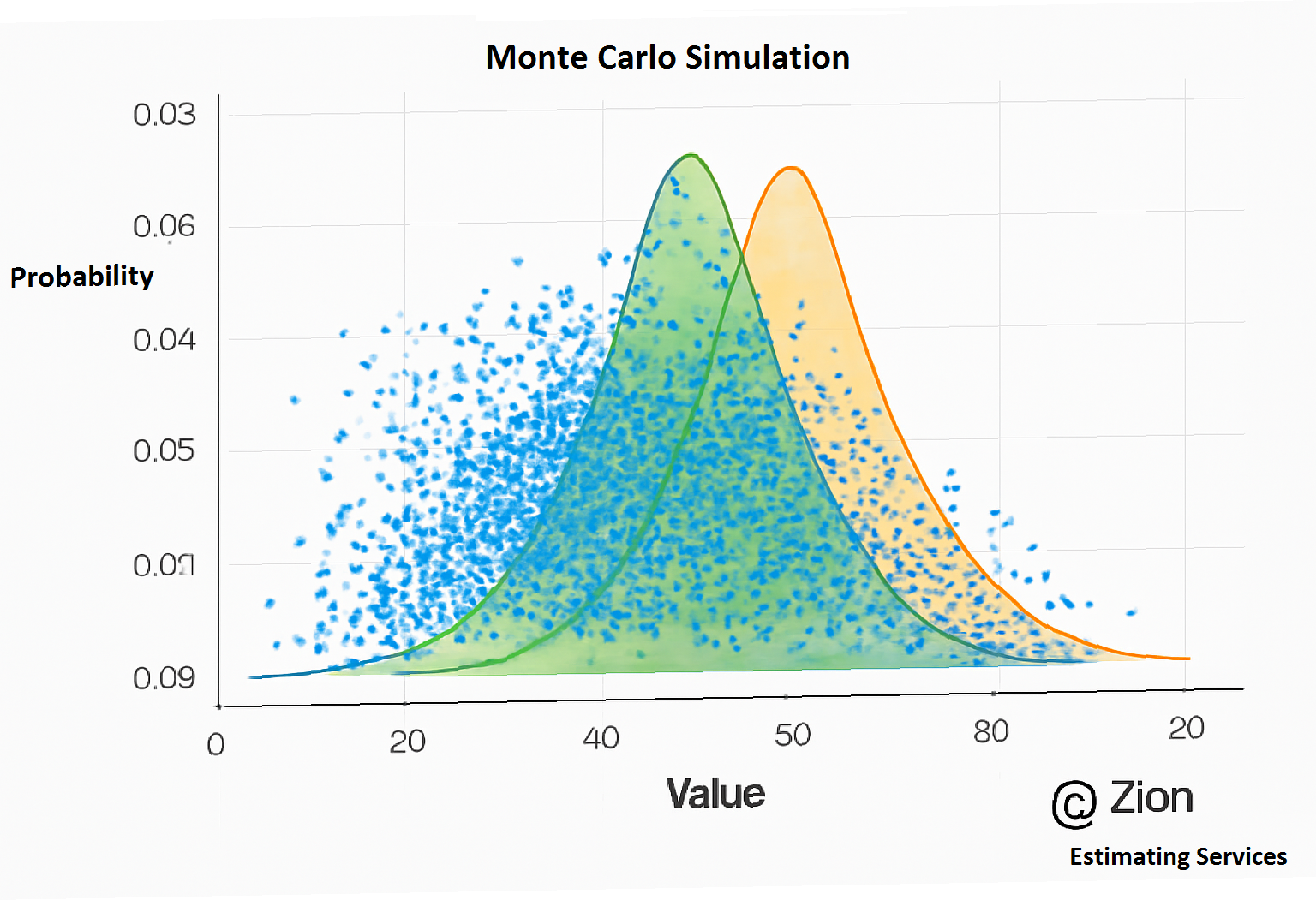Discover how Monte Carlo simulation can transform your estimating process. Learn 7 powerful techniques to improve accuracy and reduce uncertainty in your forecasts.
Introduction
Estimating the cost or time for projects can be tricky, especially when there are many variables and uncertainties at play. To navigate these complexities, many professionals turn to Monte Carlo simulation, a powerful mathematical technique that has revolutionized the way we approach risk and uncertainty in estimating.
In this blog post, we’ll dive deep into how Monte Carlo simulation can enhance your estimating process. By exploring seven powerful ways to use this method, you’ll learn how to make more accurate forecasts and improve decision-making in your projects.
What is Monte Carlo Simulation?
At its core, Monte Carlo simulation is a computational technique that uses random sampling to estimate mathematical functions and simulate the behavior of systems with inherent uncertainty. It’s like running thousands of simulations to understand the full range of possible outcomes of a given situation.
The technique is named after the Monte Carlo Casino in Monaco, as it involves the use of randomness — just like rolling dice or playing a game of chance.

Why Monte Carlo Simulation is Crucial in Estimating
-
Handling Uncertainty: Traditional estimating techniques rely on single-point estimates, which can be misleading, especially when there are many unknown variables. Monte Carlo simulation, however, factors in uncertainty by providing a range of possible outcomes, allowing for more informed decision-making.
-
Visualizing Risk: Through Monte Carlo simulations, you can visualize potential risks and probabilities in your project estimates. This gives stakeholders a clearer picture of the likelihood of meeting specific targets, such as project timelines or budget limits.
7 Powerful Ways Monte Carlo Simulation Revolutionizes Estimating
-
Risk Analysis and Management
One of the most significant advantages of Monte Carlo simulation is its ability to perform risk analysis. Traditional methods give you a single estimate — often not accounting for the variability in real-world scenarios. With Monte Carlo simulation, you can generate multiple simulations based on a range of inputs, revealing a spectrum of possible outcomes. By analyzing these results, you can identify the probability of success for various cost and schedule scenarios, allowing for better risk management.
-
Monte Carlo simulation is particularly effective for cost estimation. By modeling various cost factors, such as labor, material costs, and unforeseen expenses, the simulation allows you to account for fluctuations in these costs. The result? A more accurate projection of the total project cost and a clear understanding of potential cost overruns.
-
Schedule Forecasting
Estimating project timelines is another area where Monte Carlo simulation excels. In traditional scheduling, project managers often use deterministic estimates that don’t fully account for delays or uncertainties. Monte Carlo simulation can model the impact of delays, resource availability, and task dependencies, giving project managers a better idea of the most likely completion date and probable delays.
-
Scenario Planning
With Monte Carlo simulation, you can run what-if scenarios to understand how changes in key assumptions affect your estimates. For instance, what happens if labor costs rise by 10%? What if materials become delayed? The simulation generates multiple outcomes for these scenarios, helping you make informed decisions based on a wide array of possibilities.
-
Improved Decision-Making
By generating a probability distribution for each possible outcome, Monte Carlo simulation allows decision-makers to understand the likelihood of different outcomes. Whether you’re deciding on a budget or schedule, you’ll be able to make more data-driven decisions, backed by hard statistical evidence.
-
Optimized Resource Allocation
In many projects, resource allocation is a balancing act. Monte Carlo simulations help you determine the optimal allocation of resources by simulating different combinations of labor, equipment, and materials. This insight ensures that you don’t over or under-allocate resources, which can have significant cost and time consequences.
-
Communication and Stakeholder Buy-In
Monte Carlo simulations can enhance communication between project stakeholders. Visualizing the range of possible outcomes in an understandable format, such as a probability curve, helps stakeholders grasp the uncertainty involved in a project. This makes it easier to get buy-in for realistic budgets and timelines, reducing the likelihood of misunderstandings later in the project lifecycle.
Real-World Applications of Monte Carlo Simulation in Estimating
Monte Carlo simulation has been successfully applied in various industries for cost estimating and risk management. For instance:
-
Construction Industry: Construction projects often face unforeseen circumstances such as weather delays or material price fluctuations. Monte Carlo simulation can estimate project costs and completion times while accounting for these uncertainties.
-
Software Development: In software development, Monte Carlo simulations can estimate the time required to complete a project, factoring in uncertainties in development time, testing phases, and bug fixes.
-
Oil and Gas Industry: In the energy sector, Monte Carlo simulations can be used to forecast the cost of drilling projects, considering variables like fuel price fluctuations, labor shortages, and equipment downtime.
Steps to Implement Monte Carlo Simulation in Your Estimating Process
-
Identify Key Variables: Begin by identifying the key factors that influence your estimate — such as costs, resources, and time. For each variable, define a probability distribution (e.g., normal, triangular, or uniform).
-
Run the Simulation: Using specialized software, input your data and run the simulation. The software will generate thousands of random samples for each variable to simulate a range of possible outcomes.
-
Analyze the Results: Review the simulation results to identify the most likely outcomes and the risks involved. Focus on key metrics like the mean, median, and confidence intervals to make informed decisions.
-
Communicate Findings: Share the results with your team and stakeholders. Use clear visualizations, such as graphs and charts, to highlight the range of possible outcomes and their probabilities.
-
Make Data-Driven Decisions: Use the insights from your simulation to adjust your estimates, allocate resources, and manage risks more effectively.
Tools and Software for Monte Carlo Simulation
Several tools can help implement Monte Carlo simulation, such as:
-
@Risk: A popular add-on for Microsoft Excel, @Risk is widely used in project management, financial modeling, and risk analysis.
-
Crystal Ball: A forecasting tool that integrates with Excel, used for Monte Carlo simulations in a variety of industries.
-
Simul8: A simulation tool that provides Monte Carlo capabilities for business process modeling.
Conclusion
Monte Carlo simulation has proven to be a game-changer in estimating by providing more accurate, data-driven insights into project risks, costs, and timelines. By understanding and applying Monte Carlo simulation, you can make better-informed decisions, mitigate risks, and communicate more effectively with stakeholders.
If you want to enhance your estimating process with advanced risk analysis and improved accuracy, Monte Carlo simulation is the tool you need to take your forecasts to the next level.
Contact Zion Estimating Services Inc. today to learn more about how we can help you apply Monte Carlo simulation in your next project estimate.
